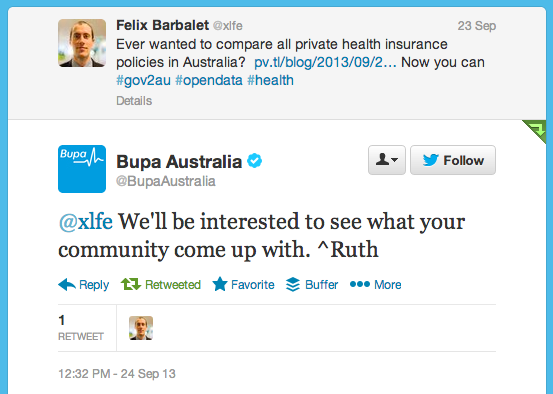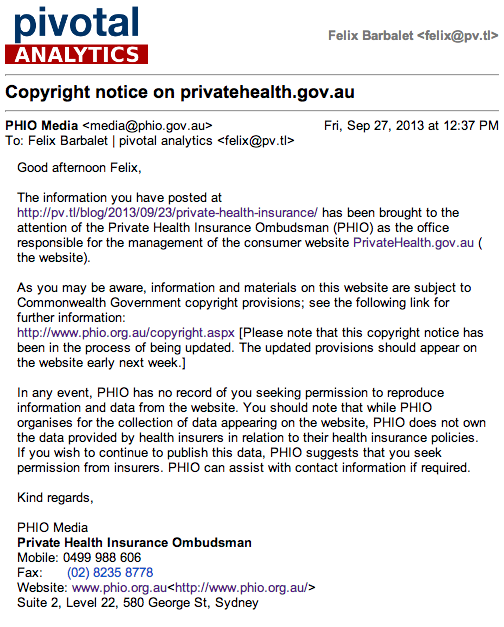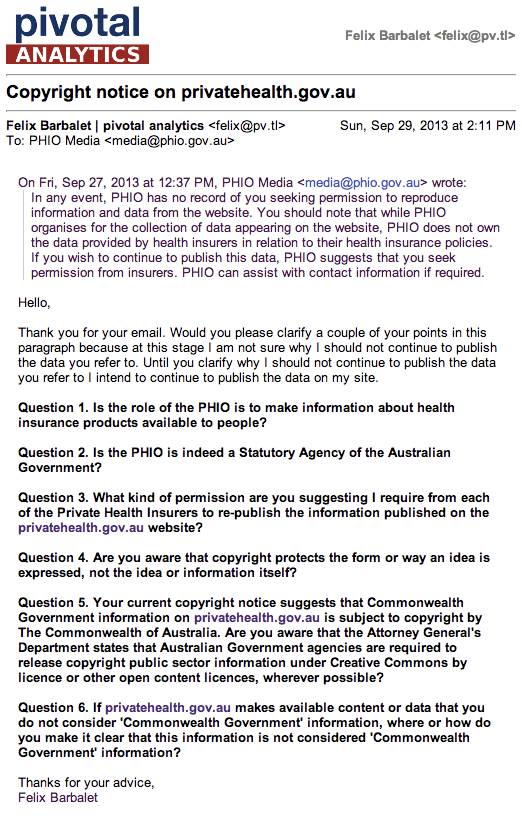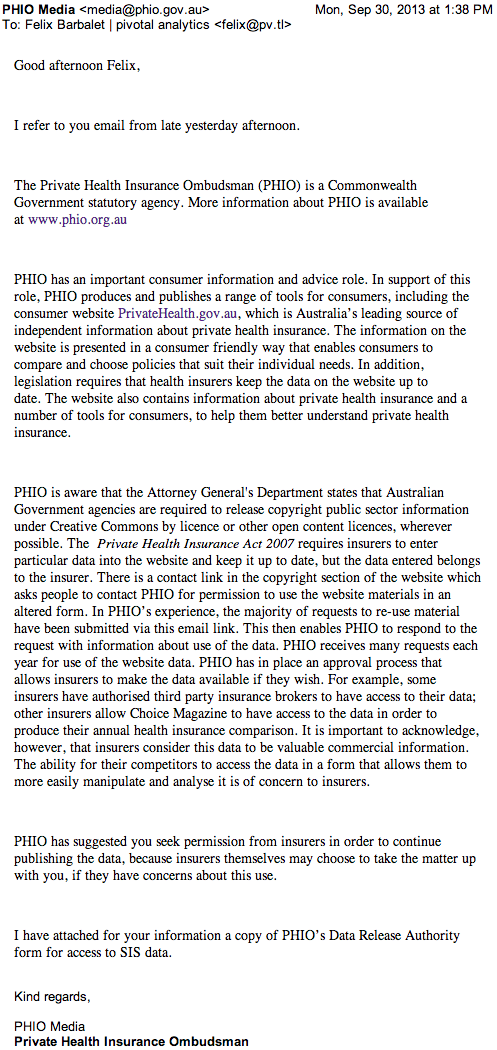Private Health Insurance Opacity - Part 1
November 21, 2013
The Australian Government declared its support for Open Government in May 2013:
The Australian Government now declares that, in order to promote greater participation in Australia’s democracy, it is committed to open government based on a culture of engagement, built on better access to and use of government held information, and sustained by the innovative use of technology.
Citizen collaboration in policy and service delivery design will enhance the processes of government and improve the outcomes sought. Collaboration with citizens is to be enabled and encouraged. Agencies are to reduce barriers to online engagement, undertake social networking, crowd sourcing and online collaboration projects and support online engagement by employees, in accordance with the Australian Public Service Commission Guidelines.
The value of these Open Government principles is one of simple economics: contestable and transparent markets are typically more efficient than those operating under conditions of monopoly. Public policy is no different. The best ideas are those that survive scrutiny and analysis. Governments have typically held a monopoly on providing public policy advice because they control access to many of the resources required to formulate that advice.
The most significant of these resources is information that feeds into public policy making. This is why the concept of Open Government relies on better access to the use of government held information.
While the declaration is a necessary step for the Australian Government to embrace increased efficiency in public policy formulation and delivery, it is far from sufficient.
Albeit that it is still early days, there is significant resistance to enabling contestability and public collaboration on public policy in some parts of the Australian Public Service.
This article details one such example in depth.
The Private Health Insurance Ombudsman (PHIO)
The PHIO is a Commonwealth Government Statutory Agency established in 2007 under the Private Health Insurance Act 2007.
Its stated aims, under the Act, include disseminating information about private health insurance and the rights and obligations of privately insured people.
That sounds pretty good - we’ve got a Government body who’s funded to provide information about private health insurance.
Unfortunately, my experience in dealing with the PHIO has been quite the opposite.
How easy is it to compare Private Health Insurance Policies?
The PHIO breathlessly claims that:
The consumer website PrivateHealth.gov.au is Australia’s leading source of independent information about health insurance for consumers.
Unfortunately, there is no basis for their claim, and data shows it to be patently false.
We can examine their claim by comparing the PHIO run website with other Australian Private Health Insurance Comparison Websites using data from Alexa (the Web Information Company):

The data shows that, in Australia, the PHIO site is ranked 5th out of these sites. Not exactly what I’d call the leading source. Infact, the other sites on the list received 460% more page views than the PHIO run site.
But let’s give the PHIO the benefit of the doubt. What if it is just the case that not many people know about the PHIO run website? What if those people that make it to the PHIO run website actually find it much more useful?
Alexa provides the following figures to test that hypothesis:

These engagements metrics are actually even more damning: they show that the PHIO run site has the highest bounce rate out of all of the listed sites; that is, two thirds of visitors to the PHIO run Private Health Comparison site leave immediately.
I was one of those who found their site to be pretty uninspiring when I tried to use it a few years ago. I forgot about that, however, until recently a colleague reminded me how difficult it was to actually compare health policies using the site.
Her experience was one of frustration. In order to compare more than a few policies at a time, she had to click through multiple pages (each very slow to load) and try to remember what previous pages had said. If she wanted more details she had to download a PDFs for every policy she was interested in and then try and switch back and forth between each to make a comparison. What a joke!
It’s no surprise to me that the PHIO run site is not particularly popular in comparison to the other sites, which use modern interfaces and actually allow you to compare policies in a quick and easy manner.
Infact this appears to be a pretty clear example of the wasteful Government provision of services which are already provided by the private sector. That’s not to say the PHIO doesn’t perform other important functions which are not performed by the private sector (for example, dispute resolution and complaints handling). It just that the PHIO clearly does not have the advantage in providing a useful comparison website to consumers.
So given all that, [I decided to compile a spreadsheet of all available Private Health Insurance Policies in Australia] (/blog/2013/09/23/private-health-insurance/). I was surprised that there were more than 43,000 policies available or previously available for sale.
My collegue and others were very pleased to be able to access a simple spreadsheet of policies which they could then examine as they saw fit.
Infact, even one of the health insurers provided encouragement:

So you might imagine my surprise upon receiving the following email from the PHIO Media Office:

At first they assert that the information is subject to Commonwealth Copyright provisions, implying that I needed to seek permission from the Commonwealth to publish the data.
This is actually wrong - Attorney-Generals Department advises that:
Australian Government agencies are required to release copyright public sector information under Creative Commons by licence or other open content licences, wherever possible.
An agency’s copyright notice can usually be found at the front or back of a published document, or through a link at the very bottom of its web pages. Contact the relevant agency’s copyright section directly if a copyright notice still refers to the CCA or requires further permission for use of the material.
(View a screenshot of AGs’ advice earlier this year).
They then go on to suggest that I should not publish the data because the data is owned by the insurers, and that I would need to seek permission from the insurers to publish the information.
So in two short paragraphs they completely contradict themselves. Either the Commonwealth holds copyright on the content and therefore it is available under a Creative Commons license, or they have published the information without reference to the fact that it is subject to a third-party claim of copyright.
In either case, they have completely misunderstood what copyright protects. If they had bothered to have a look at AGs [helpful guide] (http://www.ag.gov.au/RightsAndProtections/Documents/ShortGuidetoCopyright-October2012.pdf), they would have noted in the first paragraph of the document:
Copyright protects the form or way an idea or information is expressed, not the idea or information itself.
While their expression of the data would be covered by copyright (ie, their actual HTML pages and site layout), that is not what I was republishing. I had published just the underlying database - devoid of any creative expression.
It seems pretty clear to me that the information itself is not subject to copyright.
My response:

Unfortunately their response makes the same assertion again, and they go even further:

In my view, the last two sentences in the PHIO’s response are the most telling:
It is important to acknowledge, however, that insurers consider this data to be valuable commercial information. The ability for their competitors to access the data in a form that allows them to more easily manipulate and analyse it is of concern to insurers.
The PHIO again asserts that I need to seek permission from the insurers to publish their policy coverage and pricing data because of their concerns about the ease of manipulation and analysis of the insurers’ policy coverage and pricing.
So the PHIO, which is a publicly funded body, tasked with (from their Act) disseminating information about private health insurance appears to be attempting to enforce the (non-existent!) copyright of third-parties (the insurers) to restrict the ease of which consumers can actually compare and contrast Private Health Insurance policies.
What the?!
Now, by this stage I wasn’t sure how to proceed. So I reached out to a few people for advice.
If you, dear reader, are wondering where you can go for advice on Copyright and Government and Open Government, then please read on.
Copyright, Gov 2.0 and the Australian Government
While the Attorney-Generals Department was historically responsible for administration of Commonwealth Copyright, they no longer manage it, and advise that each agency is responsible for the management of its own copyright licenses.
So at the very top level, we have the Government declaring its commitment to Open Government, and AGs declaring that Australian Government agencies are required to release copyright public sector information under Creative Commons by licence or other open content licences, wherever possible but then each agency is responsible for implementing their own management of that policy.
I received a few suggestions that the Office of the Australian Information Commissioner might be able to offer advice on the use of the PHIO published information. I did contact them, and their initial advice was that unless my question related to the Privacy Act or Freedom of Information Act, they were unable to assist. After a discussion on twitter however, they provided the following advice:
Although the OAIC supports the greater release of public sector information, and encourages agencies to follow the Principles on open public sector information by making more information available under open licensing conditions, we have no jurisdiction over decisions of individual agencies about their copyright policies.
You may be interested in some of the concerns expressed by the Information Commissioner about current whole-of-government copyright arrangements in the February 2013 report, [Open public sector information: from principles to practice] (http://www.oaic.gov.au/information-policy/information-policy-resources/information-policy-reports/open-public-sector-information-from-principles-to-practice).
The report makes for very interesting reading (I have just asked the OAIC whether the underlying survey data is available).
Unfortunately, the overall implementation of this policy appears to be pretty haphazard; a simple comparison of the ratio of Australian Government sites [without a Creative Commons license] (https://www.google.com.au/search?q=site%3Agov.au+-%22Creative+Commons%22+Copyright) to [those with] (https://www.google.com.au/search?q=site%3Agov.au+%22Creative+Commons%22+Copyright) shows a ratio of about 100:1.
There is one fantastic resource available to Government in this space - the Australian Governments Open Access and Licensing Framework.
As an Economist, Open Government advocate and data-scientist, I feel very strongly that publicly available information should be open to remixing and reuse. I guess I’m also pretty stubborn because on matters of principle I don’t shy away from pursing a progressive outcome.
So in Part II of this saga I’ll detail the steps I’ve taken to try to get the PHIO to resolve their internal contradiction on the data they publish. If you thought Part I was interesting, wait until you read the correspondence in Part II :)
If you’d like to be notified when I publish part II, please sign up for the newsletter below.
